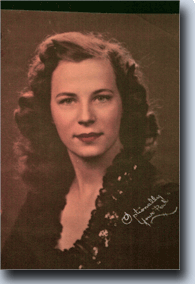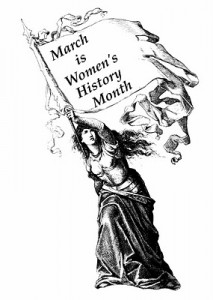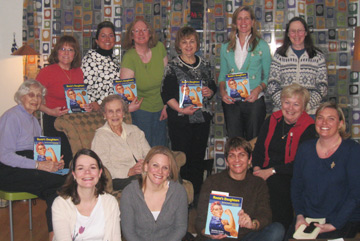Women Honoring Rosie the Riveter by Their Looks and Actions
Post #25 – Rosie’s Daughters: The “First Woman To” Generation Tells Its Story by Matilda Butler and Kendra Bonnett
Who are these women and why are they wearing Rosie the Riveter bandanas? This is one of two great photos that we received a few days ago. Want to know more? Just click here. We’ve written the full story on our Women’s Memoirs website.

{ 0 comments }
News of a Rosie’s Daughter
Post #24 – Rosie’s Daughters: The “First Woman To” Generation Tells Its Story by Matilda Butler and Kendra Bonnett
What have Rosie’s Daughters been doing? That’s the question that Kendra Bonnett and I have been investigating. I’ve just finished interviews with a number of Rosie’s Daughters in order to look at the decade of their 60s, the decade between the initial interviews in 2000 and 2010. We’ve been eager to examine both the ten years that have just passed as well as the expectations and aspirations for the coming decade.
 While doing my research, I noted the loss of one special Rosie Daughter mentioned in the first edition of this book — Jill Clayburgh. She died November 5 last year. You may have noticed the news story. But if you didn’t, she had chronic leukemia for 21 years before dying of complications of the disease. This means she must have been diagnosed about ten years after starring in the 1978 Oscar-nominated An Unmarried Woman, a movie that meant a lot to many of us in the Rosie’s Daughters generation.
While doing my research, I noted the loss of one special Rosie Daughter mentioned in the first edition of this book — Jill Clayburgh. She died November 5 last year. You may have noticed the news story. But if you didn’t, she had chronic leukemia for 21 years before dying of complications of the disease. This means she must have been diagnosed about ten years after starring in the 1978 Oscar-nominated An Unmarried Woman, a movie that meant a lot to many of us in the Rosie’s Daughters generation.
I found a quote from Clayburgh that seems particularly appropriate for all of us to consider, independent of our age. She said, “Happiness is, as Freud said, love and work.”
Clayburgh loved her work as an actor and strove to perfection, a state we never achieve but a goal worth pursuing. She also had a close family and found much love there. I’m glad she found happiness and wish all our readers success in both love and work.
Want to know more about memoir writing? Kendra and I took our experiences from writing a memoir and teaching memoir writing and have created a website designed for women who are interested in creating their own life legacy for their family. To visit that site, click here.
{ 0 comments }
Geraldine Hoff Doyle: We Take Our Hats (Oops, Bandanas) Off to You
Post #23 – Rosie’s Daughters: The “First Woman To” Generation Tells Its Story by Matilda Butler and Kendra Bonnett
 Rosie the Riveter has inspired women for decades. Young women. Older women. Her children. Her grandchildren. Even men. She is our reminder — that quiet voice telling us that indeed, We Can Do It!
Rosie the Riveter has inspired women for decades. Young women. Older women. Her children. Her grandchildren. Even men. She is our reminder — that quiet voice telling us that indeed, We Can Do It!
There was a real face behind J. Howard Miller’s now-famous World War II. That was the face of Geraldine Hoff (later Doyle). Her photograph was taken by a news wire cameraman while she was working and later chosen by Miller as the inspiration for the poster he created.
Want to know more? Visit our blog on Women’s Memoirs.
Let’s all honor Geraldine Hoff Doyle by living the strength, courage, and empowerment that she represents.
{ 1 comment }
Rosie the Riveter’s Bandana — A Fun Video
Post #22 – Rosie’s Daughters: The “First Woman To” Generation Tells Its Story by Matilda Butler and Kendra Bonnett
Click Here to visit our Rosie the Riveter’s Store for Rosie’s Bandanas, Rosie’s Mugs, and our collective memoir, Rosie’s Daughters.
Kendra and I hope you enjoy this delightful video with pictures — World War II and current — of women wearing their Rosie the Riveter bandanas. We’ve included posters from WWII and pictures of women who have bought our Rosie the Riveter bandanas. Click on the link below to go to our store where you can get your own Rosie’s Bandanas, Rosie’s Mugs, and even our award-winning collective memoir about Rosie the Riveter’s Daughters — Rosie’s Daughters, the generation of women born during WWII.
Click Here to visit our Rosie the Riveter’s Store for Rosie’s Bandanas, Rosie’s Mugs, and our collective memoir, Rosie’s Daughters.
{ 0 comments }
More Awards for collective memoir: Rosie’s Daughters: The “First Woman To” Generation Tells Its Story
Post #22 – Rosie’s Daughters: The “First Woman To” Generation Tells Its Story by Matilda Butler and Kendra Bonnett
This has been an exciting week for us. My co-author, Kendra Bonnet and I have just received notification of two national literary book awards for our collective memoir: Rosie’s Daughters: The “First Woman To” Generation Tells Its Story.
First, we learned we had won:

2010 San Francisco Book Festival, Honorable Mention
We were still celebrating, when we received notification that we had won:
 2010 Indie Excellence Book Award, Finalist
2010 Indie Excellence Book Award, Finalist
We are especially pleased to have these two new awards added to our 2008 National IPPY Award, Bronze Medal.
Want to know what has these judges so excited about our book? Click Here to read excerpts; Click Here to read reviews; and Click Here to order your autographed copy. And don’t forget, we are the only place where you can get an authentic Rosie the Riveter bandana. The book and bandana make a great gift and a perfect combo for summer reading.
Are you interested in writing your own memoir? Kendra and I have a website devoted to helping women write their own life story. Click here to visit: http://womensmemoirs.com On our site, we feature weekly memoir writing prompts, memoir book reviews, brief videos with memoir writing tips, contests, and information about book business to help you plan for and successfully launch your book. We invite you to become part of our community of women interested in memoir writing.
{ 0 comments }
The Passing of a Much-Loved Rosie the Riveter
Post #21 – Rosie’s Daughters: The “First Woman To” Generation Tells Its Story by Matilda Butler and Kendra Bonnett
Each life story is important. Those of you who follow me on http://womensmemoirs.com, the second website that Kendra Bonnett and I maintain, know that helping women tell their stories is our passion. This is a passion that grew out of the extensive interviews conducted for our book Rosie’s Daughters: The “First Woman To” Generation Tells Its Story. That was when I fully realized the value of looking back at our lives and sharing these stories.
Although most of the sharing of women’s stories takes place on our Women’s Memoirs website, we like to feature stories on this site as well. Last year, I received an email from Norma Horton Bryant who purchased our Rosie the Riveter Legacy bandana. She and her sister were on their way to England to participate in a World War II Memorial Weekend. They were going as Rosie the Riveters to celebrate their mother’s contribution to the war effort and to share her story with others.
When they returned, they wrote about their mother Marian Perkins Horton as well as their memorable trip to England. They even sent photos. With great pleasure, we published that story. Click Here to read it.
 This morning, I received an email from Marian Perkins Horton’s granddaughter, Heather Fanguy. She wrote: “Our ‘Nanny’ Marian passed away from a heart attack yesterday afternoon. Thank you for including her story in your work. Sharing her life has given us great pride, peace and comfort during her struggle with Alzheimer’s and especially now during our time of loss.”
This morning, I received an email from Marian Perkins Horton’s granddaughter, Heather Fanguy. She wrote: “Our ‘Nanny’ Marian passed away from a heart attack yesterday afternoon. Thank you for including her story in your work. Sharing her life has given us great pride, peace and comfort during her struggle with Alzheimer’s and especially now during our time of loss.”
We extend our sympathy to the Horton family.
It is our hope that we all remember the value of our life stories and find ways to record and share them with others.
{ 0 comments }
Telephone Call with Book Club
Post #20 – Rosie’s Daughters: The “First Woman To” Generation Tells Its Story by Matilda Butler and Kendra Bonnett
Tuesday evening I had a great experience. Kendra and I have met with book clubs before, but I’d never met with one via the telephone. This group of women arrived at Diana’s home in Arlington Heights, just outside Chicago. About 15 members gathered around 7 PM. That gave them time to say hi to each other, grab a cup of tea, and get settled. One person who couldn’t attend even managed to listen in via her own phone connection.
Meanwhile, I was in California getting ready. I had a fresh pot of my favorite lemon-ginger tea and a treasured Japanese teacup. I pulled a copy of Rosie’s Daughters: The “First Woman To” Generation from the shelf by my desk. It turns out that I didn’t need it, but I like having it nearby for reference. Once I was ready, I resumed working on a chapter for a new book (Writing Alchemy: How to Turn Your Words into Gold) until the phone rang.
It only took a couple of minutes to get the connection made and the speaker phone in a good position. Let the fun began. I talked a little about the genesis of Rosie’s Daughters and the journey I’ve been on since 2000 when I got the idea for this book. My life path was changed by the more than 100 women I interviewed. I became aware of the need for women to tell and value their life stories. After the book was completed, I delved into the area of memoir writing, started a website called Women’s Memoirs, developed teaching materials, and began offering memoir writing workshops at colleges and privately.
The group was generous in letting me talk about my dual passions for the message of empowerment in Rosie’s Daughters and women’s memoir writing. Then I answered their questions. A really great one focused on the role of women in the work force today if there had not been a World War II. I’ve never been asked that before and found it a thought-provoking concept.
The book club has promised a picture of the group. If they send me a copy, I’ll post it on this blog.
Meanwhile, if you have a book club that would like to read Rosie’s Daughters, please let us know. We’d be delighted to use a conference call to discuss the book.
I’d like to give my thanks to Diana, who hosted the book club, and to Lara, who made all the arrangements with me. It was especially heartening to hear that the group, representing different ages, felt the content worked especially well across generations.
{ 0 comments }
Another “First Woman To” Story
In our collective memoir, Rosie’s Daughters, Kendra and I document the women born during World War II who went on to become the “First Woman To” Generation.
Of course, there continue to be barriers to be broken. Last night, a woman won the Best Director Oscar for the first time. While these achievements are important in their own right, it is the stories behind the achievements that are even more important.
Below is a YouTube video with interviews of Kathryn Bigelow, Best Director award winner, and Sandra Bullock, Best Actress award winner. (Sorry, it has an opening ad, but the video is such a good one that it is worth the short commercial.) Both of these strong women show us that one needs to keep trying and to accept the failures along with the accolades. They are all part of life.
In case you didn’t follow the Oscars this year, Kathryn Bigelow became the first female winner of the Best Director Oscar category. Her film, The Hurt Locker also won the Best Picture award.
There have only been three other female nominees is the entire history of the Oscars that spans 82 years. The others are: Linda Wertmüller (1976, Seven Beauties), Jane Campion (1993, The Piano), and Sofia Coppola (2003, Lost in Translation).
{ 0 comments }
Women’s History Month, Education and Politics
 I’ve been busy blogging on Women’s Memoirs lately, but wanted to get back to Rosie’s Daughters as we enter March — Women’s History Month. In our book, Kendra and I provide information on many “First Woman To” Generation women, famous and not famous, who are making important contributions to society. Their contributions continue and they seek new challenges with a wonderful openness and enthusiasm. Personal politics aside, I was rooting for Kay Bailey Hutchison, a FW2 woman. Having met the challenges of being a senator, she took up the task of running for governor of Texas. Yesterday, she lost in the primary. But I don’t think that will be the end of it. She may continue as the senior Senator from Texas (the most senior Republican woman in the Senate) or resign as she indicated when she began her run to be the governor of Texas. Or, she may turn to her next goal. Either way, like so many FW2 Generation woman, she will pursue her passion and make her contribution.
I’ve been busy blogging on Women’s Memoirs lately, but wanted to get back to Rosie’s Daughters as we enter March — Women’s History Month. In our book, Kendra and I provide information on many “First Woman To” Generation women, famous and not famous, who are making important contributions to society. Their contributions continue and they seek new challenges with a wonderful openness and enthusiasm. Personal politics aside, I was rooting for Kay Bailey Hutchison, a FW2 woman. Having met the challenges of being a senator, she took up the task of running for governor of Texas. Yesterday, she lost in the primary. But I don’t think that will be the end of it. She may continue as the senior Senator from Texas (the most senior Republican woman in the Senate) or resign as she indicated when she began her run to be the governor of Texas. Or, she may turn to her next goal. Either way, like so many FW2 Generation woman, she will pursue her passion and make her contribution.
Well, I got off my topic: Women’s History. So often a movement gets started for political reasons. However, the story of Women’s History Month shows that it grew out of a combination of political and education needs. If you don’t know the story, here’s a little information:
1. In the US the Socialist Party organized the first National Women’s Day in 1909. Now before you roll your eyes at the mention of the Socialist Party, remember that in 1909 women did not have the right to vote and the Socialist Party was one of the organizations that took up that cause. They wanted to draw attention to the right to vote that was denied to women.
2. Merely a year later, the Socialist International Party declared an International Women’s Day with a message of the need for universal suffrage. The first celebration was held in 1911 with a continuing emphasis on the women’s right to vote, but also calling for the end to job discrimination. The celebration of International Women’s Day was on March 19. Then, tragically, only six days later, the now infamous Triangle Fire in New York City killed 140 young women working in the garment industry. Locked in the work room, they were unable to escape. The fire brought additional interest to the agenda of the International Women’s Day to protect female workers.
3. Continuing with the international emphasis, Russian women held peace rallies in 1913 and 1914 in conjunction with International Women’s Day. And in 1917, they organized and carried out a stroke for “bread and peace.”
Although some of these celebrations were held on the last day of February, most were held in March.
4. Fast forward to 1978. Obviously, women now had the right to vote in the US. The passage of the Civil Rights Act of 1964 also included the statement in Section 703 (a) that made it unlawful for an employer to “fail or refuse to hire or to discharge any individual, or otherwise to discriminate against any individual with respect to his compensation, terms, conditions or privileges or employment, because of such individual’s race, color, religion, sex, or national origin.”
So with voting rights ensured and workplace discrimination official ended, you might wonder about the need for an new emphasis on women’s history. In 1961, Ester Peterson was the Director of the Women’s Bureau that collected data about many aspects of women’s work lives. She persuaded President Kennedy to establish a non-partisan Commission on the Status of Women, which he did, naming Eleanor Roosevelt as Chair. The Commission issued its report in 1963 that documented discrimination in many areas of women’s lives. As a result of that report, many states and counties established their local Commissions. Many of these had committees looking at the status of women in education.
My personal story gets intertwined with history at this point. I was active in establishing several committees to investigate the role of women in my field, communication. I went on to write a book called Women and the Mass Media: Sourcebook for Research and Action that summarized all the studies available of the presentation of women in the media, including textbooks.
I make the point about textbooks because many of the commissions on the status of women began to document the invisibility of women in the K-12 curriculum. In an effort to draw more attention to the roles women have played in history, Sonoma County’s Commission organized a Women’s History Week for 1978. Many of the schools in the county eagerly participated with guest speakers and new materials used.
This marked the beginning of a new effort to recognize the importance of women in society.
5. The following year, Molly Murphy MacGregor, a member of the Sonoma County Commission’s Education Task Force, was included in a program at The Women’s History Institute at Sarah Lawrence College. MacGregor’s description of Sonoma county’s successful program excited the other national leaders who agreed to start similar efforts through their organizations. But more importantly, they saw the need to work together to establish a National Women’s History Week.
6. The next step forward came in 1980. At that time, President Jimmy Carter issue a Presidential Proclamation making the Week of March 8th, 1980 National Women’s History Week. At this point, we’re back to politics again. Carter’s resolution was specifically for 1980. Representative Barbara Mikulski and Senator Orrin Hatch worked together to co-sponsor a Congressional Resolution for 1981 establish National Women’s History Week.
Each year, organizations banded together to lobby for National Women’s History Week because each proclamation and resolution was only for one specific year.
7. By 1987, while national efforts were still initiated on a yearly basis, 14 states had declared March as Women’s History Month. In that same year, Congress declared the entire month of March as the permanent National Women’s History Month.
 As you read this summary, I hope you noticed that it began in 1909, 11 years before women had the right to vote. That was the same year that my mother was born. I always have to stop to remind myself of the not-too-distant past when women couldn’t vote.
As you read this summary, I hope you noticed that it began in 1909, 11 years before women had the right to vote. That was the same year that my mother was born. I always have to stop to remind myself of the not-too-distant past when women couldn’t vote.
Then I hope you also noticed how recently there was recognition of National Women’s History Month. This was established on a permanent basis only in 1987.
.
{ 0 comments }
FW2 Joan Baez on PBS
Post #17 – Rosie’s Daughters: The “First Woman To” Generation Tells Its Story by Matilda Butler and Kendra Bonnett
On this blog, we sometimes feature stories of that generation of women born during World War II, daughters of the iconic Rosie the Riveter. Other times, we look at stories of the women who worked during the war, the Rosie’s themselves, because they took the first step toward opening occupations to women. Of course, they managed to also raise an incredible generation of women, many of whom were the first to graduate from college in their families or the first female to hold the jobs they sought and won.
Today, I’d like to highlight a PBS documentation about one of the many women in the generation of Rosie’s Daughters that we call the “First Woman To (FW2)” Generation. Joan Baez. Actually, all you have to do is say her name and you see a face and hear a voice that resonates with many of us. PBS recently aired in the American Masters Series a broadcast called Joan Baez: How Sweet the Sound.
As someone who came of age politically in the 1960s, the interwoven history and music in the documentary brought back memories — the Civil Rights and Peace Movements, Bob Dylan’s music, and much more. I was touched to see the recent conversation between Joan Baez and Davis Harris in the documentary.
But most of all, I loved hearing Baez talk about how comfortable she is on stage where once her fear caused her to regularly flee, even in the middle of a concert. It is a reminder to all of us to embrace what we’ve done, both the good and the not-so-good, and to become comfortable with ourselves at this point in our lives.
The following video, although not from How Sweet the Music, is Joan singing Love is Just a Four Letter Word. Enjoy.
Missed the PBS viewing? I just checked and you can rent it through NETFLIX.
{ 0 comments }




 Subscribe to our feed!
Subscribe to our feed!


